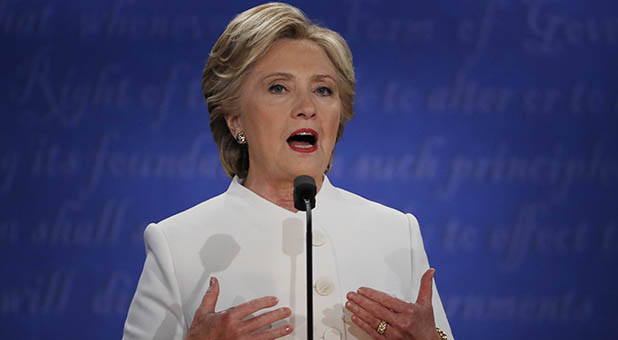Hillary’s Hurricane Hysteria Blows an Ill Wind
As if natural destruction along the east coast from Hurricane Matthew wasn’t enough, manmade bluster blew into Florida last week in the form of tropical storm experts Hillary Clinton and Al Gore. Of course they blamed the ferocity of the hurricane on “carbon pollution.” That’s a given.
Beyond the cyclonic rhetoric focused on this one dramatic seasonal event, it seems some in the science profession, largely academics, have discovered that they know the future of Earth’s entire climate. Their crystal ball is climate models. Their experience is located in front of a computer screen.
I have been a practitioner in the atmospheric-science community for nearly four decades, working as a weather observer above the Arctic Circle and a field technician in central Illinois, managing high-profile environmental projects and modeling air quality. Over the years, I have interacted with other professionals on the job and at scientific society meetings, especially at conferences of the American Meteorological Society and Air & Waste Management Association.
As an insider, I have heard substantial skepticism of catastrophic global climate change firsthand from experienced meteorologists and practicing environmental scientists and engineers. Generally older professionals are more likely to doubt the current talking points of man-caused climate disaster. After all, older pros, like me, lived through the period in the 1960s and 70s when the coming ice age was all the rage.
Today, the coming sweltering globe is all the rage.
But science is all about perspective. Science includes theory and practice. Academics are typically steeped in theory. Those beyond the ivory towers have pretty much applied theory to practice and so have quite a different take on what atmospheric data are telling us about our future climate.
Meteorologists, humbled so many times by inaccurate weather forecasts, may be the biggest skeptics of climatologists’ confidence in decades-hence global climate outlooks.
And when climatological-type projections that can be verified are examined, they demonstrate good reason to be skeptical.
For example, cycling back to hurricanes, consider the mid-2000s heyday of climate hysteria, the days of Al Gore’s An Inconvenient Truth.
Just prior to the onset of the Atlantic hurricane season in May of 2006, the official U.S. hurricane center forecast stated that it would be another season of unusually numerous events (although not on a par with the record-breaking 31 of 2005, which included 15 hurricanes). However, the forecast was a bust, with only 10 events recorded (5 hurricanes and 5 tropical storms). Keep in mind that in the average year there are about 15 events.
The point is simply this: Forecasting short-term climatic conditions is at least as difficult as forecasting next weekend’s weather.
Subsequent years up to the present day, regardless of long-term expectations and the path of Hurricane Matthew, have wrought little extensive hurricane activity in the U.S.
If the number of severe storm events for a small portion of the globe cannot be accurately predicted, then what are we to make of the substantially more complicated and difficult task of long-range planet-wide climate forecasting?
Earth’s climate is tremendously complex, and though we understand it better today than we did decades ago, we are still a long way from being able to accurately forecast climate conditions decades into the future.
Add to this that crisis-mongering in the form of declaring certain climate doom is harmful to the climate science profession. The mongering runs the discipline like a shady business. And it is particularly harmful to people. It soaks the middle class with higher energy costs and deprives the world’s poor of a better future.
But crisis can certainly serve an over-reaching administration. Government funding targets topics the government has declared critical. These topics attract researchers seeking funding. Conclusions are drawn that support the crisis and the need for further research. And on it goes. Business is booming.
Yet supposed catastrophic climate change from increased carbon emissions as promoted by politicians and the administration is not a fact; it’s a prediction based on a hypothesis. The prediction is a convenient one that is sufficiently nebulous and far enough out (the permanent sweltering of mid-latitude cities by mid-century, for example), that the hyping and embellishing of outrageous prognostications can only be endured, not refuted.
So when headliner climate gurus like Clinton and Gore, along with President Obama, Leonardo DiCaprio and Pope Francis urge immediate action on controlling the atmosphere, an air of caution is advised. Because, when it comes to this dubious climate claim, politicians provide the muscle and money, actors spread the script and clerics preach the Scripture.
As for academics’ confident knowledge of Earth’s climate future—their knowledge is rooted in hubris. And as clerics know, “Pride goes before the fall.” {eoa}
Anthony J. Sadar is a certified consulting meteorologist, author of In Global Warming We Trust: Too Big to Fail (Stairway Press, 2016), and a contributing writer for The Cornwall Alliance for the Stewardship of Creation.














































